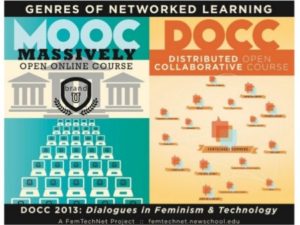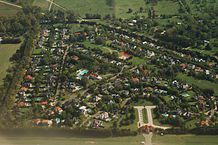
Slide from Elizabeth Losh, PowerPoint presentation Future-U, June 22, 2015
This November I read the four blogs on the role of technology in digital learning, published on http://dmlcentral.net/ by Nishant Shah and two of his colleagues at Leuphana Digital School[i]. I learned that discussions on digital learning are mainly about interfaces, licenses and content management systems, at least until around 2015. Experts on digital learning did not reflect on what we make technologies do, what role we make technologies perform. For Shah and his colleagues that role is: connecting people who are located at a distance from each other, and bringing together all the different tools we have for education. Shah searches in this discussion for a new concept. Instead of connected learning or connectivity he would like to use the concept of distributed learning and he argues that consolidation is the role of technologies of online learning.
Digital education as a collective experience
Students are not seen as disconnected participants, located somewhere else, isolated from other participants, but they are part of the bigger picture and become active and affective learners. It’s about collectivity rather than connectivity, Mariam Haydeyan shows us in the second blog. In addition not one lecturer teaches the course, but a large team is involved in creating the different educational tools such as keynote lectures and case studies, and multiple practitioners serve as teachers as well. Education is a collective experience and learners are organized in a group, supported by mentors (content-related support) and tutors (administrative and technical support), working together as a team and being part of a community. All courses are built around the principle of peer-to-peer learning.
As an example of how digital learning works as a process of distribution the authors describe the Mentored MOOC[ii] “Managing the Arts” of Leuphana Digital School. This course on marketing of cultural organizations incidentally had over 17,000 users from more than 100 countries. Therefore Shah prefers the name: Open Online Course, Accidentally Massive (in blog 4). The three colleagues show how important the supporting team behind the course is. The project manager and other team members who facilitate the course are the centre of the network. As Christian Friedrich, head of project management and interviewed by Shah in the last blog, states: “We orchestrate the work of mentors, teachers, experts, film crew, publishers, university administration, IT infrastructure and we make sure that we don’t overstep any boundaries, when it comes to legal issues or certification, for example.” Shah thinks the concept of connected learning excludes the role of the administrative resources that are not visible and, hence, become infrastructure. Distributed learning on the other hand “requires…to locate the agency that is needed and the labour that goes into the making of consolidated learning.” (Quote from blog 4)
Over fifteen years ago, in 1998-1999, as a student assistant, I was involved in the development of the first online platform for a course within the History programme of Utrecht University. We used the platform, built in WebCT, only as a tool for distributing information otherwise given in readers. We did not abandon the reader…that included the guidelines for using the platform. And, as I remember correctly, compulsory literature was included too. Essays were handed in online instead of on paper. But the students were educated in the classroom, literature was discussed in that same classroom. Two years later we used the digital platform for tests and assignments. We partly replaced books and papers with the computer and online content, but still just to support education in the classroom. Later on digital learning became a video of the lecturer in front of the camera, supported by a digital environment where students could post questions and find literature references. But of course you can do much more than that with digital technologies. Shah wants to show this by using this other concept. He argues that digital learning is about bringing together resources and people. And we must think about how technologies can be used to support this in the best way. As Elizabeth Losh[iii] suggested in her presentation at Future-U (http://digital.leuphana.com/future-u/future-u-compilation/), June 22, 2015, MOOC’s are something else than DOCC’s: Distributed Open Collaborative Courses (see also picture above).
Co-creation and commitment in a safe community
Jonathan Worth is cited when seeking for the main question to keep in mind when designing online courses. He asked in the workshop Future-U (http://digital.leuphana.com/future-u), June 22, 2015, “How do we create an experience in which we add value for the learning when learning with the digital?” The answer of Haydeyan is “affect” (blog 2). As the participants work as a team on the assignments, they learn from each other, and in this way a strong commitment is created. This form of learning enables also a sustainable learning outcome, as Haydeyan states. Ann-Kathrin Watolla underlines this in the third blog. Students are not seen as merely receivers of knowledge but as co-creators of content. She argues that to facilitate this without a fixed agenda “is key, and a vital aspect in designing digital education formats” (blog 3). In this new approach of education lecturers do not stand above students. Learners are on the same level as the teachers and other inputs through educational materials. It is a many to many teaching approach. At the end of her blog Watolla wonders: “[…] if one teacher is no longer enough, is there also a limit to the number of teachings?”
Leuphana courses are organized in a closed environment, in which everybody can feel safe to express their opinion. Their statements on the forum will not be indexed by Google, and therefor will not to be found forever on the internet, Friedrich explains in the interview in blog 4. There is another side to this: one excludes many people who could contribute with other insights and ideas. In a way the digital community here is a gated community.
Gated Community, photo by Alex Steffler[iv]
Being at the centre of the see-saw, towards a new pedagogy
Shah recalls in the last blog the concept of distributed learning, with the conclusion “that a shift from connectivity to distributedness offers us new modes of experimenting with peer learning, mentorship, and pedagogy.” But it is not about replacing connected learning by distributed learning. One wants to see all processes and possibilities and use the best of it for designing digital learning environments. As Shah puts it: “we want to be at the centre of the see-saw, where all these processes pass through.”
[i] Blog 1: Nishant Shah, ‘The role of Technology in Digital Learning’, July 23, 2015, http://dmlcentral.net/the-role-of-technology-in-digital-learning/ accessed on November 17, 2016.
Blog 2: Mariam Haydeyan, ‘The Power of Decntralization in the MOOC’, July 30, 2015, http://dmlcentral.net/the-power-of-decentralization-in-the-mooc/ accessed on November 17, 2016.
Blog 3: Ann-Kathrin Watolla, ‘Rethinking the Educator’s Role Toward Distributed Teaching’, August 06, 2016, http://dmlcentral.net/rethinkgin-the-educator-s-role-toward-distributed-teaching/ accessed on November 17, 2016.
Blog 4: Nishant Shah, ‘Enhancing Connected, distributed Learning’, August 13, 2015, http://dmlcentral.net/enhancing-connected-distributed-learning/ accessed on November 17, 2016.
[ii] Massive Open Online Course
[iii] Elizabeth Losh is director of academic programs sixth college, UC San Diego, http://losh.ucsd.edu/.
[iv] Originally posted to Flickr as Barrio cerrado near Ezeiza, CC BY 2.0 https://commons.wikimedia.org/w/index.php?curid=6876435

